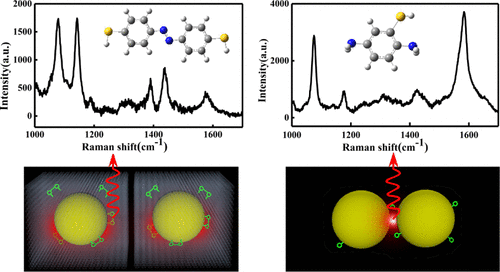当前位置:
X-MOL 学术
›
Anal. Chem.
›
论文详情
Our official English website, www.x-mol.net, welcomes your
feedback! (Note: you will need to create a separate account there.)
Plasmon-Driven Interfacial Catalytic Reactions in Plasmonic MOF Nanoparticles
Analytical Chemistry ( IF 6.7 ) Pub Date : 2021-09-21 , DOI: 10.1021/acs.analchem.1c02272 Xin Xie 1 , Yaoyao Zhang 2 , Lingjun Zhang 1 , Jiangen Zheng 1 , Yingzhou Huang 1 , Huanbao Fa 2
Analytical Chemistry ( IF 6.7 ) Pub Date : 2021-09-21 , DOI: 10.1021/acs.analchem.1c02272 Xin Xie 1 , Yaoyao Zhang 2 , Lingjun Zhang 1 , Jiangen Zheng 1 , Yingzhou Huang 1 , Huanbao Fa 2
Affiliation

|
Benefiting from the noble metal nanoparticle core and organic porous nanoshell, plasmonic metal–organic frameworks (MOFs) become a nanostructure with great enhancement of the electromagnetic field and a high density of reaction sites, which has fantastic optical properties in surface plasmon-related fields. In this work, the plasmon-driven interfacial catalytic reactions involving p-aminothiophenol to 4,4′-dimercaptoazobenzene (trans-DMAB) in both the liquid and gaseous phases are studied in plasmonic MOF nanoparticles, which consist of a Ag nanoparticle core and an organic shell (ZIF-8). The surface-enhanced Raman spectroscopy (SERS) spectra recorded at the plasmonic MOF in an aqueous environment demonstrate that the reversible plasmon-driven interfacial catalytic reactions could be modulated by a reductant (NaBH4) or oxidant (H2O2). Also, the situ SERS spectra also point out that plasmonic MOF (AgNP@ZIF-8) nanoparticles exhibit much better catalytic performance in the H2O2 solution compared to pure Ag nanoparticles for the anti-oxidation caused by the MOF shell. It is surprising that although there is greater SERS enhancement obtained at pure Ag nanoparticles, the plasmon-driven interfacial catalytic reactions only occur at plasmonic AgNP@ZIF-8 nanoparticles in the gaseous phase. This interesting phenomenon is further confirmed and analyzed by simulated electromagnetic field distributions, which could be understood by the effective capture of gaseous molecules by the organic porous nanoshell. Our work not only explores the plasmonic MOF nanoparticles with unique optical properties but also strengthens the understanding of plasmon-driven interfacial catalytic reactions.
中文翻译:

等离子体 MOF 纳米粒子中等离子体驱动的界面催化反应
受益于贵金属纳米粒子核和有机多孔纳米壳,等离子体金属-有机骨架(MOF)成为一种具有极大增强电磁场和高密度反应位点的纳米结构,在表面等离子体相关领域具有出色的光学特性。在这项工作中,等离子体驱动的界面催化反应涉及对氨基苯硫酚到 4,4'-二巯基偶氮苯(反式-DMAB) 在等离子 MOF 纳米粒子中研究了液相和气相,该纳米粒子由 Ag 纳米粒子核和有机壳 (ZIF-8) 组成。在水性环境中等离子体 MOF 处记录的表面增强拉曼光谱 (SERS) 光谱表明,可逆等离子体驱动的界面催化反应可以通过还原剂 (NaBH 4 ) 或氧化剂 (H 2 O 2 )进行调节。此外,原位 SERS 光谱还指出等离子体 MOF (AgNP@ZIF-8) 纳米粒子在 H 2 O 2 中表现出更好的催化性能溶液与纯银纳米粒子相比,用于由 MOF 壳引起的抗氧化。令人惊讶的是,尽管在纯 Ag 纳米粒子上获得了更大的 SERS 增强,但等离子体驱动的界面催化反应仅发生在气相中的等离子体 AgNP@ZIF-8 纳米粒子上。这种有趣的现象通过模拟电磁场分布得到进一步证实和分析,这可以通过有机多孔纳米壳有效捕获气态分子来理解。我们的工作不仅探索了具有独特光学特性的等离子体 MOF 纳米粒子,而且还加强了对等离子体驱动的界面催化反应的理解。
更新日期:2021-10-06
中文翻译:

等离子体 MOF 纳米粒子中等离子体驱动的界面催化反应
受益于贵金属纳米粒子核和有机多孔纳米壳,等离子体金属-有机骨架(MOF)成为一种具有极大增强电磁场和高密度反应位点的纳米结构,在表面等离子体相关领域具有出色的光学特性。在这项工作中,等离子体驱动的界面催化反应涉及对氨基苯硫酚到 4,4'-二巯基偶氮苯(反式-DMAB) 在等离子 MOF 纳米粒子中研究了液相和气相,该纳米粒子由 Ag 纳米粒子核和有机壳 (ZIF-8) 组成。在水性环境中等离子体 MOF 处记录的表面增强拉曼光谱 (SERS) 光谱表明,可逆等离子体驱动的界面催化反应可以通过还原剂 (NaBH 4 ) 或氧化剂 (H 2 O 2 )进行调节。此外,原位 SERS 光谱还指出等离子体 MOF (AgNP@ZIF-8) 纳米粒子在 H 2 O 2 中表现出更好的催化性能溶液与纯银纳米粒子相比,用于由 MOF 壳引起的抗氧化。令人惊讶的是,尽管在纯 Ag 纳米粒子上获得了更大的 SERS 增强,但等离子体驱动的界面催化反应仅发生在气相中的等离子体 AgNP@ZIF-8 纳米粒子上。这种有趣的现象通过模拟电磁场分布得到进一步证实和分析,这可以通过有机多孔纳米壳有效捕获气态分子来理解。我们的工作不仅探索了具有独特光学特性的等离子体 MOF 纳米粒子,而且还加强了对等离子体驱动的界面催化反应的理解。











































 京公网安备 11010802027423号
京公网安备 11010802027423号